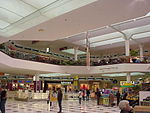HM Prison Geelong
1864 establishments in Australia1991 disestablishments in AustraliaConvictism in AustraliaDefunct prisons in GeelongPrison museums in Australia ... and 2 more
Tourist attractions in GeelongUse Australian English from December 2011

HM Prison Geelong was a maximum security Australia prison located on the corner of Myers Street and Swanston Street in Geelong, Victoria, Australia. The prison was built in stages from 1849 to 1864. Its panopticon design is based on Pentonville Prison in England. The prison was officially closed in 1991 and prisoners were moved to the newly built HM Prison Barwon in Lara. The building now functions as a museum for the history of the prison.
Excerpt from the Wikipedia article HM Prison Geelong (License: CC BY-SA 3.0, Authors, Images).HM Prison Geelong
Swanston Street, Geelong Geelong
Geographical coordinates (GPS) Address External links Nearby Places Show on map
Geographical coordinates (GPS)
| Latitude | Longitude |
|---|---|
| N -38.153888888889 ° | E 144.36555555556 ° |
Address
Old Geelong Gaol
Swanston Street
3219 Geelong, Geelong
Victoria, Australia
Open on Google Maps









